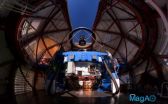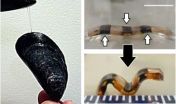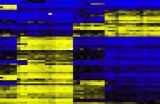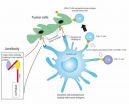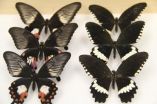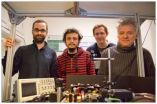(Press-News.org) University of Arizona researchers snapped images of a planet outside our solar system with an Earth-based telescope using essentially the same type of imaging sensor found in digital cameras instead of an infrared detector. Although the technology still has a very long way to go, the accomplishment takes astronomers a small step closer to what will be needed to image earth-like planets around other stars
"This is an important next step in the search for exoplanets because imaging in visible light instead of infrared is what we likely have to do if we want to detect planets that might be suitable for harboring life," said Jared Males, a NASA Sagan Fellow in the UA's Department of Astronomy and Steward Observatory and lead author on a report to be published in The Astrophysical Journal.
Even though the image was taken at a wavelength that is just shy of being visible to the human eye, the use of a digital camera-type imaging sensor – called a charge-coupled device or CCD – opens up the possibility of imaging planets in visible light, which has not been possible previously with Earth-based telescopes.
"This is exciting to astronomers because it means we now are a small step closer to being able to image planets outside our solar system in visible light," said Laird Close, a professor in the Department of Astronomy, who co-authored the paper.
He explained that all the other Earth-based images taken of exoplanets close to their stars are infrared images, which detect the planets' heat. This limits the technology to Gas Giants – massive, hot planets young enough to still shed heat. In contrast, older, possibly habitable planets that have cooled since their formation don't show up in infrared images as readily, and to image them, astronomers will have to rely on cameras capable of detecting visible light.
"Our ultimate goal is to be able to image what we call pale blue dots," Close said. "After all, the Earth is blue. And that's where you want to look for other planets: in reflected blue light."
The photographed planet, called Beta Pictoris b, orbits its star at only nine times the Earth-Sun distance, making its orbit smaller than Saturn's. In the team's CCD images, Beta Pictoris b appears about 100,000 times fainter than its host star, making it the faintest object imaged so far at such high contrast and at such relative proximity to its star. The new images of this planet helped confirm that its atmosphere is at a temperature of roughly 2600 degrees Fahrenheit (1700 Kelvin). The team estimates that Beta Pictoris b weighs in at about 12 times the mass of Jupiter.
"Because the Beta Pictoris system is 63.4 light years from Earth, the scenario is equivalent to imaging a dime next right next to a lighthouse beam from more than four miles away," Males said. "Our image has the highest contrast ever achieved on an exoplanet that is so close to its star."
The contrast in brightness between the bright star and the faint planet is similar to the height of a 4-inch molehill next to Mount Everest, Close explained.
In addition to the host star's overwhelming brightness, the astronomers had to overcome the turbulence in Earth's atmosphere, which causes stars to twinkle and telescope images to blur. The success reported here is mostly due to an adaptive optics system developed by Close and his team that eliminates much of the atmosphere's effect. The Magellan Adaptive Optics technology is very good at removing this turbulence, or blurring, by means of a deformable mirror changing shape 1,000 times each second in real time.
Adaptive optics have been used for more than 20 years at observatories in Arizona, most recently at the Large Binocular Telescope, and the latest version has now been deployed in the high desert of Chile at the Magellan 6.5-meter telescope.
The team also imaged the planet with both of MagAO's cameras, giving the scientists two completely independent simultaneous images of the same object in infrared as well as bluer light to compare and contrast.
"An important part of the signal processing is proving that the tiny dot of light is really the planet and not a speckle of noise," said Katie Morzinski, who is also a Sagan Fellow and member of the MagAO team. "I obtained the second image in the infrared spectrum – at which the hot planet shines brightly – to serve as an unequivocal control that we are indeed looking at the planet. Taking the two images simultaneously helps to prove the planet image on the CCD is real and not just noise."
Males added: "In our case, we were able to record the planet's own glow because it is still young and hot enough so that its signal stood out against the noise introduced by atmospheric blurring."
"But when you go yet another 100,000 times fainter to spot much cooler and truly earthlike planets," Males said, "we reach a situation in which the residual blurring from the atmosphere is too large and we may have to resort to a specialized space telescope instead."
INFORMATION:
Development of the MagAO system was made possible through the strong support of the National Science Foundation MRI, TSIP and ATI grant programs. The Magellan telescopes are operated by a partnership of the Carnegie institute, the University of Arizona, Harvard University, Massachusetts Institute of Technology and the University of Michigan. The work of NASA Sagan Fellows Jared Males and Katie Morzinski was performed in part under contract with the California Institute of Technology funded by NASA through the Sagan Fellowship Program executed by the NASA Exoplanet Science Institute.
A small step toward discovering habitable earths
For the first time, UA astronomers have used the same imaging technology found in a digital camera to take a picture of a planet far from our solar system with an Earth-based telescope
2014-03-05
ELSE PRESS RELEASES FROM THIS DATE:
Researchers find potential target for drug to treat allergic asthma
2014-03-05
COLUMBUS, Ohio – An enzyme that helps maintain immune system function by "throwing away" a specific protein has a vital role in controlling symptoms of allergic asthma, new research in mice suggests.
The finding suggests that this enzyme, called Cbl-b, could be a target for drugs used to treat allergic asthma and other autoimmune disorders.
This new study, led by Ohio State University researchers, is the first to link Cbl-b to allergic asthma in an animal model.
The findings parallel results from a 2012 Yale study in humans, which suggested that a mutation in the ...
Pumping iron: A hydrogel actuator with mussel tone
2014-03-05
Protein from a small, tasty mollusk inspired Michigan Technological University's Bruce P. Lee to invent a new type of hydrogel actuator.
Hydrogels are soft networks of polymers with high water content, like jello. Because of their soft, gentle texture, they have the potential to interact safely with living tissues and have applications in a number of medical areas, including tissue engineering. Lee, an assistant professor of biomedical engineering, wanted to make a hydrogel that wouldn't just sit there.
"Hydrogels that can change shape on command could be used to deliver ...
Going viral to target tumors
2014-03-05
March 5, 2014, New York, NY– A Ludwig Cancer Research study suggests that the clinical efficacy of checkpoint blockade, a powerful new strategy to harness the immune response to treat cancers, might be dramatically improved if combined with oncolytic virotherapy, an investigational intervention that employs viruses to destroy tumors.
Published today in the journal Science Translational Medicine, the study evaluated a combination therapy in which the Newcastle disease virus (NDV), a bird virus not ordinarily harmful to humans, is injected directly into one of two melanoma ...
Biomarkers of cell death in Alzheimer's reverse course after symptom onset
2014-03-05
Three promising biomarkers being studied to detect Alzheimer's disease in its early stages appear to undergo a surprising shift as patients develop symptoms of dementia, researchers at Washington University School of Medicine in St. Louis report.
Scientists use the biomarkers to assess brain changes linked to the disease in research volunteers. The levels of markers of neuronal injury increase in the spinal fluid for a decade or more before the onset of dementia, but in a new twist, the research shows for the first time that they later reverse course, decreasing as symptoms ...
An inventive new way to profile immune cells in blood
2014-03-05
ROVIDENCE, R.I. [Brown University] — When a person becomes sick or is exposed to an unwelcome substance, the body mobilizes specific proportions of different immune cells in the blood. Methods of discovering and detecting those profiles are therefore useful both clinically and in research. In a new paper in the journal Genome Biology, a team of scientists describes a new and uniquely advantageous way to detect them.
All the current means of counting immune cells in a blood sample require whole cells, said Karl Kelsey, professor of epidemiology at Brown and corresponding ...
Novel cancer vaccine holds promise against ovarian cancer, mesothelioma
2014-03-05
A novel approach to cancer immunotherapy – strategies designed to induce the immune system to attack cancer cells – may provide a new and cost-effective weapon against some of the most deadly tumors, including ovarian cancer and mesothelioma. Investigators from the Massachusetts General Hospital (MGH) Vaccine and Immunotherapy Center report in the Journal of Hematology & Oncology that a protein engineered to combine a molecule targeting a tumor-cell-surface antigen with another protein that stimulates several immune functions prolonged survival in animal models of both ...
Hungry for 'likes': Frequent Facebook use linked to eating disorder risk, study finds
2014-03-05
TALLAHASSEE, Fla. — Frequent Facebook users might be sharing more than party pictures, vacation videos and shameless selfies — they also share a greater risk of eating disorders, according to a new study led by Florida State University researchers.
Psychology Professor Pamela K. Keel studied 960 college women and found that more time on Facebook was associated with higher levels of disordered eating. Women who placed greater importance on receiving comments and "likes" on their status updates and were more likely to untag photos of themselves and compare their own photos ...
Prenatal nicotine exposure may lead to ADHD in future generations
2014-03-05
TALLAHASSEE, Fla. — Prenatal exposure to nicotine could manifest as attention deficit hyperactivity disorder in children born a generation later, according to a new study by Florida State University College of Medicine researchers.
Professors Pradeep G. Bhide and Jinmin Zhu have found evidence that ADHD associated with nicotine can be passed across generations. In other words, your child's ADHD might be an environmentally induced health condition inherited from your grandmother, who may have smoked cigarettes during pregnancy a long time ago. And the fact that you never ...
A single gene, doublesex, controls wing mimicry in butterflies
2014-03-05
A single gene regulates the complex wing patterns, colors and structures required for mimicry in swallowtail butterflies, report scientists from the University of Chicago, March 5 in Nature. Surprisingly, the gene described, doublesex, is already well-known for its critical role in sexual differentiation in insects.
"Conventional wisdom says that it should be multiple genes working together to control the whole wing pattern of a butterfly," said Marcus Kronforst, Neubauer Family Assistant Professor of Ecology & Evolution at the University of Chicago and senior author ...
Ultra sensitive detection of radio waves with lasers
2014-03-05
Radio waves are used for many measurements and applications, for example, in communication with mobile phones, MRI scans, scientific experiments and cosmic observations. But 'noise' in the detector of the measuring instrument limits how sensitive and precise the measurements can be. Now researchers at the Niels Bohr Institute have developed a new method where they can avoid noise by means of laser light and can therefore achieve extreme precision of measurements. The results are published in the prestigious scientific journal, Nature.
'Noise' in the detector of a measuring ...
LAST 30 PRESS RELEASES:
Injectable breast ‘implant’ offers alternative to traditional surgeries
Neuroscientists devise formulas to measure multilingualism
New prostate cancer trial seeks to reduce toxicity without sacrificing efficacy
Geometry shapes life
A CRISPR screen reveals many previously unrecognized genes required for brain development and a new neurodevelopmental disorder
Hot flush treatment has anti-breast cancer activity, study finds
Securing AI systems against growing cybersecurity threats
Longest observation of an active solar region
Why nail-biting, procrastination and other self-sabotaging behaviors are rooted in survival instincts
Regional variations in mechanical properties of porcine leptomeninges
Artificial empathy in therapy and healthcare: advancements in interpersonal interaction technologies
Why some brains switch gears more efficiently than others
UVA’s Jundong Li wins ICDM’S 2025 Tao Li Award for data mining, machine learning
UVA’s low-power, high-performance computer power player Mircea Stan earns National Academy of Inventors fellowship
Not playing by the rules: USU researcher explores filamentous algae dynamics in rivers
Do our body clocks influence our risk of dementia?
Anthropologists offer new evidence of bipedalism in long-debated fossil discovery
Safer receipt paper from wood
Dosage-sensitive genes suggest no whole-genome duplications in ancestral angiosperm
First ancient human herpesvirus genomes document their deep history with humans
Why Some Bacteria Survive Antibiotics and How to Stop Them - New study reveals that bacteria can survive antibiotic treatment through two fundamentally different “shutdown modes”
UCLA study links scar healing to dangerous placenta condition
CHANGE-seq-BE finds off-target changes in the genome from base editors
The Journal of Nuclear Medicine Ahead-of-Print Tip Sheet: January 2, 2026
Delayed or absent first dose of measles, mumps, and rubella vaccination
Trends in US preterm birth rates by household income and race and ethnicity
Study identifies potential biomarker linked to progression and brain inflammation in multiple sclerosis
Many mothers in Norway do not show up for postnatal check-ups
Researchers want to find out why quick clay is so unstable
Superradiant spins show teamwork at the quantum scale
[Press-News.org] A small step toward discovering habitable earthsFor the first time, UA astronomers have used the same imaging technology found in a digital camera to take a picture of a planet far from our solar system with an Earth-based telescope


